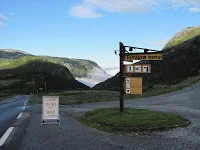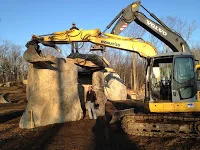A distant foghorn, waves lapping against the harbor shore and the “blow” from a humpback whale surfacing in the bay; these are the sounds that often greet visitors coming to English Harbour, Newfoundland. This summer’s workshop goal will be to create a companion piece to the “Mock Maze” that was built in 2012. Participants will collaborate on creating a design, and then construct it on the grounds of the art center.
Read MoreRecently, I was a guest reader during a lecture by Gordon Hayward about his most recent book, Gardening on Granite, at the New Canaan Nature Center. The book was commissioned and privately published by our friend and client, Teddy Berg. Between its 160 pages of photographs and prose is a beautifully documented story of building and planting a mountaintop garden in Walpole, New Hampshire. I worked intermittently, over an 18-year period, creating walls, features and follies on Teddy and Peter Berg’s property to create the framework for Gordon’s garden designs and installations.
Read MoreEvery baker knows it takes good ingredients to make a tasty pie. Now that plans for the dry stone workshop at Turtagrø, Norway have come together, I can see that our week in July is going to be a fantastic time. We have a beautiful setting, excellent accommodations and an abundance of building stone. All that’s missing are a few more enthusiastic folks to sign up and meet us at Tutagrø. I hope you will be the one who completes the pie!
Read MoreModeling clay is one of my favorite sketch materials. It reveals more about the true reality of an idea than a drawing does. Manipulating materials on a small scale runs up against some of the same issues that will be present when constructing a full scale rendition in stone.
Read MoreGetting to work with skilled professionals under the direction of an artist who takes great joy in the making of things is pure delight for me. This week I was again on Hogpen Hill with Edward Tufte creating monumental lithic assemblages. From time to time, over the past year, I’ve gone to western Connecticut to collaborate with my stone-loving colleague. With each session, we’ve explored new ways to combine large stones with the landscape. The stones are dug up from just under the surface of the ground near the assembly points. Each “foundling” is a gift of unique shape and texture bringing with it another possibility for construction.
Read MoreThe best two days in the life of a dry stone project are the first and the last. The first day is full of anticipation about how the great unknown will reveal itself. The course of the work has been formulated in the mind, but the process that will lead to an end only begins when an actual stone is laid. That initial stone sets in motion a chain-reaction of events, a series of choices that ultimately determine the character of the finished work.
Read MorePaul Bowen brought his Marlboro College sculpture class students to my work site today for a flash course in dry stone walling, and an outdoor "gallery" tour of nearby installations. My normally quiet scene became very lively for an hour as the group practiced building a field-stone retaining wall.
Read MoreMy project this month is the construction of a series of retaining walls for an existing perennial garden. A brook trickles from the bank at the top of the garden and flows through a channel between two of the new walls. The grotto will become an ice cavern in winter months and a cool, shady retreat in the heat of summer.
Read More“Walls of Snowdonia”; it could be the title of a fantasy video game featuring my stoneworks. But, no, Snowdonia is a real place, and although I did make some stone wall repairs in Wales while visiting Philip Clark in the early 1990’s those walls are not included in this folio of beautiful photographs by Peter Ogwen Jones, Walls of Snowdonia. In fact, these beautiful examples of the waller’s craft were constructed more than a century ago. They continue to stand as testaments to the enduring value, practical and aesthetic, of handmade structures in the living landscape.
Read MoreThis is the season of color and light. Sunbeams stream through disrobed forest canopy, illuminating leaf-confettied ground. At this time of year the great outdoors acts like a psychedelic on my mind. Bathed in the kaleidoscope colors of autumn, I believe wishes can come true. Ever since the Dummerston town pound was recreated three years ago by 44, dry stone workshop participants, I’ve been obsessed with the idea of it being used to impound some real, live farm animals.
Read MoreEdward Tufte and the crew at Hogpen Hill Farms stayed busy on the land while I was away in Newfoundland and Oregon. An exciting collection of stones greeted me on arrival this past Monday. Edward’s sketches illustrated the direction he wished to move the work. Frank, Rob, Tom and I got right into it, constructing an 14’ high A-frame shaped piece. By Wednesday we were back on the ridgeline connecting the network of dolmens built earlier in the summer with high cross-members. A three-stone colossus now frames a dramatic view of the extended works.
Read MoreWhen I’ve thought of the people who lived on the land that’s now America, one, two, ten thousand years ago, I’ve imagined that they led a simple, subsistence lifestyle. But after visiting an ancient agate adit in central Oregon I now have to adjust my vision of the past to include a more sophisticated cultural landscape.
Read MoreThe 34-stone construction is made from stream-worn “pillow” basalt boulders gathered from a gravel bank along the Santiam River in Mill City, Oregon and 70 year-old hand split, cast-offs collected from an abandoned granite quarry in Haines, Oregon. The stones are held in place by gravity and friction aided by stainless steel pins for lateral strength. The total weight of the piece is 15 tons, the largest stone weighing 4 tons. The piece covers a 10’x30’ area and is 6’ tall at it’s highest point.
Read MoreThe 34-stone construction is made from stream-worn “pillow” basalt boulders gathered from a gravel bank along the Santiam River in Mill City, Oregon and 70 year-old hand split, cast-offs collected from an abandoned granite quarry in Haines, Oregon. The stones are held in place by gravity and friction aided by stainless steel pins for lateral strength. The total weight of the piece is 15 tons, the largest stone weighing 4 tons. The piece covers a 10’x30’ area and is 6’ tall at it’s highest point.
Read MoreI’m delighted by this new-found perspective which has been amplified this past week by my being in Bend, Oregon. The city of 80,000 has doubled its population in the past 20 years. The increase is due in large measure by the influx of people like Jeff Fairfield and his wife Samantha. Both Maine natives, they moved to the Bend area 6 years ago to begin their careers building dry stone walls and teaching horseback riding. Jeff’s joining me on the Tarriance at COCC this week got the project off to a great start. After taking delivery on 15 tons of stone we made full-scale, foam board, mock-ups of the individual pieces. With them I could quickly try out different granite slab and basalt boulder arrangements.
Read MorePast workshops have sketched a wave on the footprint of a derelict old field wall by establishing a guide frame with rope and artist easels, and bringing stones to points just under the line. Another group hiked to a remote beach and made a circle of stones on the crest of the high-water mark. It was only a visible as a piece of environmental art from the air. The English Harbour village and coastal cliffs along the famous Skerwink Trail were also viewable from Dave Paddon’s float plane.
Read MoreThe last day on our transcontinental journey begins in Twin Falls, Idaho. By this afternoon we should be at our Oregon destination for the installation of a sculpture at the Central Oregon Community College. The O.H. and I have tag-team driven from Eastern Newfoundland across three provinces and twelve states in the past week and a half with just a 2-day stop at home in Vermont to unpack and repack the car. The weather has been cooperative, only occasional rain-storms and wind gusts to impede our westerly progress.
Read MoreEach morning a pair of loons fly from the high forest pond behind the house to the wide ocean bay at the bottom of the road. In the evening they make a return flight. They punctuate their daily routines with an intermittent call and response, stuttering laughs that draws me out onto the deck to watch them wing past. This is high entertainment in the TV and internet-free environment I’ve been living in the past two weeks. The radio here is powered by a hand crank. After five minutes of broadcast the signal cuts out and I have to decide if the listening is worth the effort to recharge the battery.
Read More
















